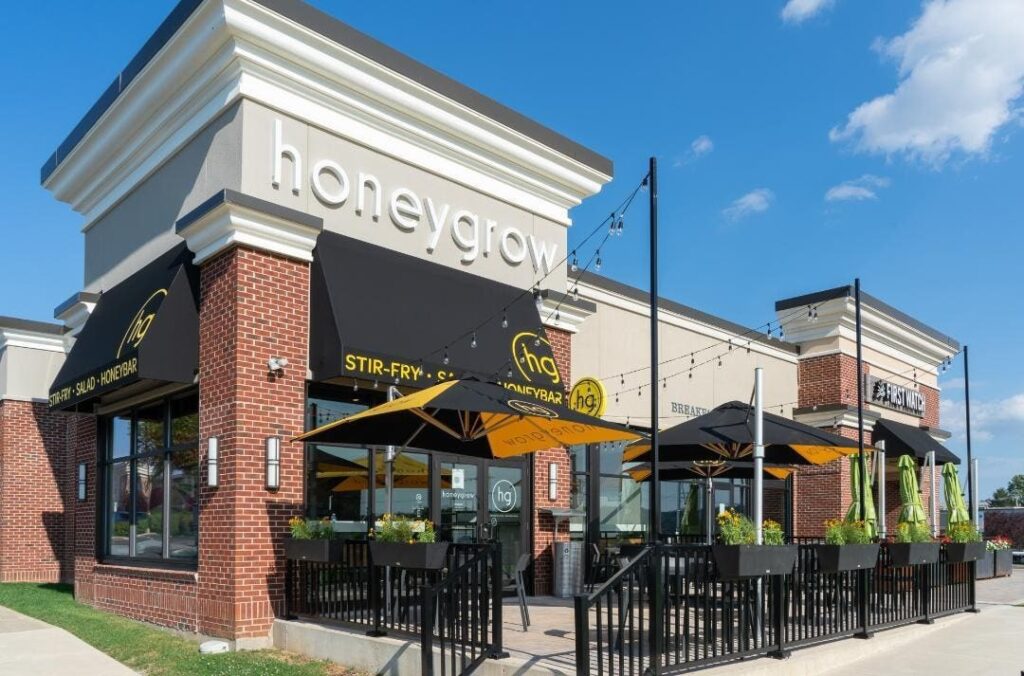
Background
Since its first fast-casual restaurant opened in Philadelphia, Pennsylvania, in 2012, honeygrow has been known for its customizable stir-fry and salad dishes made with fresh, locally sourced, wholesome ingredients. The company currently has over 40 restaurant locations from Boston to DC and utilizes 100% digital ordering.
John Paul Thomas, honeygrow’s Vice President of Operations Services, said that the restaurant leans heavily into its use of technology—even by today’s standards. Every customer who orders from the restaurant places their order digitally, whether through a kiosk in the restaurant, the mobile app, the honeygrow web ordering site, or a third-party platform like DoorDash, UberEats or Grubhub.
“What that means is our tech needs to work,” explained Thomas. “It’s just as important as power or water—we can’t sell a stir-fry without electricity or gas, nor could we without technology.”
The collaboration with Worldlink began several years ago. Based on previous experience while working for national retail chain Five Below, a member of the honeygrow executive team initiated contact with Worldlink. At that time, honeygrow only required Worldlink’s assistance in a minor capacity, primarily helping with technology installation for a few new store openings. However, as honeygrow ramped up growth and its technology needs increased, the partnership with Worldlink expanded.
Problem
honeygrow encountered several challenges as it transitioned from a small start-up business to a flourishing multi-location company. With plans to increase expansion efforts, Thomas and his team knew securing comprehensive technology solutions and enhanced support was crucial. The company’s internal IT team was big enough to support the existing restaurants but did not have the capacity to perform installs and setups for every new restaurant opening (NRO).
Other problems honeygrow experienced with NRO included a lack of consistency in new restaurant tech setups and inadequate office space to store equipment for the new restaurants. These issues led to complications for the installers and restaurant staff, as well as delays in the tech installation process.
According to Thomas, some equipment for a new location was being shipped to the office and other equipment was going to the restaurant—all on different days and times.
As a result, items would get misplaced or lost. That meant when the tech team showed up to perform the installation, some of the equipment wouldn’t be there.
“Our internal staff didn’t have the skillset or resources to handle these NRO tasks, but it didn’t make sense to hire a new team,” said Thomas. “And that’s where Worldlink was able to step in and do our new restaurant buildout for us from a tech perspective.”
“We don’t have a warehouse and we only have a little office with about 15 desks in it. We’re on the ninth floor, so if we started receiving pallets of equipment at the office, that’s going to be a significant problem. We don’t have the bandwidth, space or the functionality to receive and stage all that equipment, we needed a partner that could do those things for us. Someone who could optimize the process.”
Solution

“We had some people cold call and reach out to us, but I didn’t take any of it too seriously. Mostly because I’ve had such positive experiences with Worldlink from a customer service and support and relationship standpoint. That means so much to me,” said Thomas.
Worldlink facilitated a uniform implementation of the technology for each new restaurant location by creating a “store in a box service.” Through this service, Worldlink orders, receives, and stores the equipment for each honeygrow new restaurant opening. Then, Worldlink palletizes and coordinates the delivery of the restaurant’s equipment to the location and sends a tech team to perform the installation, including all the programming, setup and testing of the devices.
Beyond the “store in a box service,” Worldlink has brought a higher level of support to the honeygrow team and is quick to offer solutions to problems they face. “In a recent meeting with Worldlink, we discussed how one reason it was challenging to hand everything over to their team was because we didn’t have the time to document the processes appropriately,” explained Thomas. “Soon after, Worldlink showed up at our office, sat behind our tech team, and observed how we performed the tasks locally before sending equipment to a new restaurant; then, they documented it all and wrote the book for us.”
This all-in approach from Worldlink helped honeygrow to overcome one of the biggest, most time-consuming obstacles—process documentation. “I just found that to be impressive, and we were so grateful because it’s really going to take us to the next step and took a huge load off our plate.”
Outcomes
The collaboration between honeygrow and Worldlink yielded several positive results, demonstrating the effectiveness of their partnership:
Cost and Time Savings:
The streamlined “store in a box service” from Worldlink meant honeygrow didn’t incur the added expense of sending technicians on multiple trips to new restaurants for installations. Because all the equipment shows up on one pallet, the tech team can perform the installation efficiently in one visit, without having to waste time locating equipment. If something is missed or delayed, Worldlink is responsible for ensuring it gets processed and shipped expeditiously.
“From a writing a check standpoint, it’s the opportunity costs—the time of our people that can then be spent on other things, which is just so hard to measure,” said Thomas. “We gained back a great deal of hours in travel, a great deal of hours working at those new restaurant openings—we’re now able to work on other projects.”
A True Business Partnership
Thomas highlighted that Worldlink is not a typical vendor but a true business partner. Rather than a transactional relationship, honeygrow and Worldlink have a win-win relationship. He explained that Worldlink is as good or better than having an entire internal tech team devoted to new restaurant openings.
Even with only 41 honeygrow locations, Thomas said honeygrow is potentially getting the same level of service from Worldlink as a company that has 3,500 locations. He called it a huge win—something that kind of feels like a service he shouldn’t be able to afford.
“We’re at the point right now—still small, but with such rapid growth—that we need partners who will be true business partners and humans that are going to look out for us and want to grow with us. And that’s been Worldlink,” said Thomas.
Enhanced Processes and Operations
According to Thomas, collaborating with Worldlink has allowed honeygrow to experience a much more uniform implementation of technology for each new location. “That uniformity makes support easier, it makes operations easier, it makes training easier. So it’s certainly been a logistics improvement. It’s been a uniformity and consistency improvement and a huge time-saver.”
Thomas explained that Worldlink has lifted the NRO processes off honeygrow’s internal tech team and expanded their capacity to focus on other things. Now, honeygrow can do what it does best.
“Even when we become large enough to afford our own internal tech team for new restaurant openings, I’m of the belief that we should be really great at making stir-fry and let those, like Worldlink, who are good at the other things help us,” said Thomas.
“Let’s have a trusted partner that does it for us, rather than trying to be a master of everything. Worldlink has allowed us to grow at the rate we’re growing and helped us to do it better than we could have done it by ourselves.”
You can download a copy of the case study here.